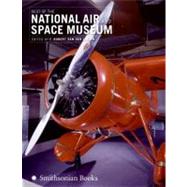
The New copy of this book will include any supplemental materials advertised. Please check the title of the book to determine if it should include any access cards, study guides, lab manuals, CDs, etc.
The Used, Rental and eBook copies of this book are not guaranteed to include any supplemental materials. Typically, only the book itself is included. This is true even if the title states it includes any access cards, study guides, lab manuals, CDs, etc.
Chapter One
Apollo 11 Command Module Columbia
Dimensions:
Diameter 3.2 m (10 ft., 2.25 in.)
Length 3.9 m (12 ft., 10 in.)
Weight 5,900 kg (13,000 lb.)
On July 20, 1969, the crew of Apollo 11 fulfilled President John F. Kennedy's challenge to land a man on the Moon and safely return him to Earth. The culmination of the intense space race between the United States and the Soviet Union, this trip was a technological and political victory for the United States.
The Apollo 11 command module Columbia was the living quarters for the three-man crew during most of the first manned lunar landing mission. On July 16, Neil Armstrong, Edwin "Buzz" Aldrin, and Michael Collins climbed into Columbia for their eight-day journey. The command module was one of three parts of the Apollo 11 spacecraft. The other two were the service module and the lunar module.
The service module contained the main spacecraft propulsion system and consumables -- oxygen, water, propellants, and hydrogen. The lunar module Eagle was the part Armstrong and Aldrin used to descend to the Moon's surface. The command module is the only portion of the spacecraft that returned to Earth.
For the launch, the lunar module was stored in a cone-shaped adapter between the service module and the Saturn V launch vehicle. Once the spacecraft was on its way to the Moon, the command and service modules (CSM) pulled away from the adapter, turned around, and docked with the lunar lander. After the CSM/lunar lander combination reached the Moon, Armstrong and Aldrin entered the lunar module and undocked from Columbia. Collins remained in lunar orbit while his crewmates landed on the Moon's surface.
Following their historic landing and exploration of the Moon's surface, Armstrong and Aldrin rejoined Collins aboard Columbia. Collins, as command module pilot, fired the CSM's large engine and headed back to Earth. Several days later, on July 24, they discarded the service module and entered Earth's atmosphere.
The exterior of Columbia is covered with an epoxyresin ablative heat shield, which prevented the module from burning and vaporizing when it entered the atmosphere at a speed of 40,000 km/h (25,000 mph) with an exterior temperature of 2,760°C (5,000°F). Columbia finished its flight with a parachute landing in the Pacific Ocean, where the USS Hornet retrieved it and its crew.
The cone-shaped spacecraft is divided into three compartments: forward, crew, and aft. The forward compartment is at the cone's apex, the crew compartment is in the center, and the aft compartment is in the base, or blunt end, of the craft. The forward compartment contained the parachutes and recovery equipment around the tunnel and hatch for passage to and from the lunar module. The crew compartment has a volume of 5.9 cu m (210 cu. ft.). It contains three couches for the crew during launch and landing. The couches are arranged so that each astronaut faces the main instrument panel. During flight, the astronauts folded the couches up to make more room in the spacecraft. Near the feet of the couches, in the lower equipment bay, there is enough room to stand up.
When Apollo 11 lifted off, the spacecraft and launch vehicle combination stood 111 m (364 ft.) tall. Eight days later, when the flight ended, the only part recovered was the 3.3-m (11-ft.) tall Columbia command module.
Columbia was transferred to the National Air and Space Museum in 1970. It has been designated a Milestone of Flight by the museum and is prominently displayed near the 1903 Wright Flyer.
Best of the National Air and Space Museum. Copyright © by F. Robert van der Linden. Reprinted by permission of HarperCollins Publishers, Inc. All rights reserved. Available now wherever books are sold.
Excerpted from Best of the National Air and Space Museum by F. Robert Van der Linden
All rights reserved by the original copyright owners. Excerpts are provided for display purposes only and may not be reproduced, reprinted or distributed without the written permission of the publisher.